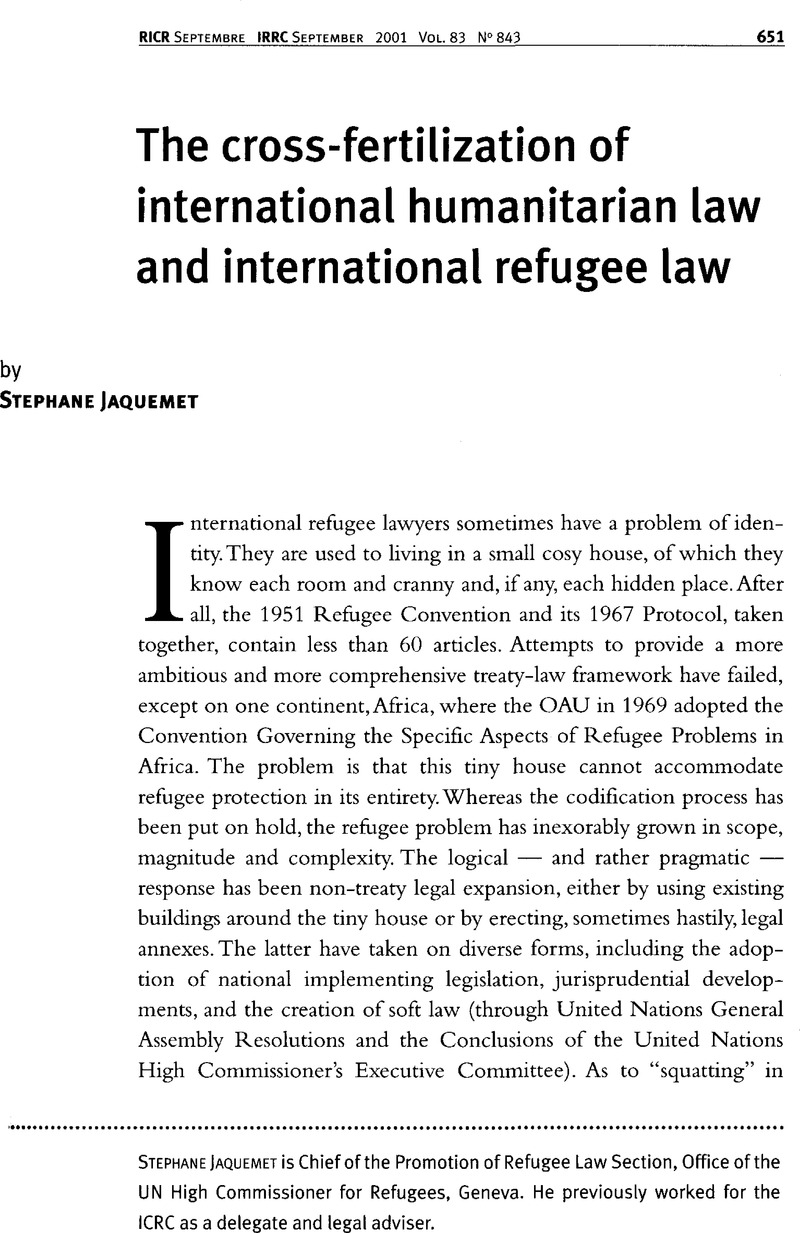Article contents
The cross-fertilization of international humanitarian law and international refugee law
Published online by Cambridge University Press: 19 April 2010
Abstract

- Type
- Research Article
- Information
- International Review of the Red Cross , Volume 83 , Issue 843: 5Oe anniversaire de la Convention sur les réfugiés de 1951. La protection des réfugiés dans les conflits armés/50th Anniversary of the 1951 Refugee Convention. The Protection of Refugees in Armed Conflict , September 2001 , pp. 651 - 674
- Copyright
- Copyright © International Committee of the Red Cross 2001
References
1 See Krill, Françhise, “ICRC's action in aid of refugees”, IRRC, No. 265, July-August 1988, pp. 328–350;Google ScholarLavoyer, Jean-Philippe, “Refugees and internally displaced persons: International humanitarian law and the role of the ICRC”, IRRC, No. 305, March-April 1995, pp. 162–180;Google Scholar International Committee of the Red Cross, “Internally displaced persons: The mandate and role of the International Committee of the Red Cross”, IRRC, No. 838, June 2000, pp. 491–500.
2 With respect to international armed conflicts, there is a small deficiency or gap inthe protection offered by the Geneva Conventions. The gap has been largely but not entirely bridged by Article 73 of Protocol I. See Krill, op. cit.(note 1), p. 330 f.
3 Grahl-Madsen, Atle, Commentary on the Refugee Convention 1952, UNHCR, Geneva,1997, p. 42.Google Scholar
4 Robinson, Nehemiah, Convention relating to the Status of Refugees: Its History, Contents and Interpretation, reprinted by UNHCR, Geneva, 1997, p. 67.Google Scholar
5 See in particular Part III of the (Fourth)Geneva Convention relative to the Protection of Civilian Persons in Time of War of12 August 1949.
6 Article 7 of the 1951 Convention.
7 Pictet, Jean S. (ed.), Geneva Convention relative to the Protection of Civilian Persons in Time of War: Commentary, ICRC, Geneva, 1958, p. 264.Google Scholar
8 Bugnion, Franςois, Le Comité international de la Croix-Rouge et la protection des victimes de la guerre, ICRC, Geneva, 1994, p. 380.Google Scholar
9 Including Article 3 common to the 1949 Geneva Conventions and several provisions of the 1977 Additional Protocol II.
10 Judgment of Trial Chamber II in theDusko Tadic case, 7 May 1997, para. 613.
11 For the former Yugoslavia and Rwanda, respectively.
12 As at l May 2001.
13 As at 1 May 2001.
14 See, e.g., Shaw, Malcolm N., International Law, 4th ed., Cambridge University Press, 1997, p. 658.Google Scholar
15 UNHCR, Handbook on Procedures and Criteria for Determining Refugee Status under the 1951 Convention and the 1967 Protocol relating to the Status of Refugees, Geneva, January 1992, p. 19.Google Scholar
16 Dinstein, Yoram, “Refugees and the law of armed conflict”, Israel Yearbook on HumanRights, Vol. 12, 1982, p. 102.Google Scholar
17 Pictet, Jean S. (ed.), Geneva Convention relative to the Treatment of Prisoners of War:Commentary, ICRC, Geneva, 1960, p. 543.Google Scholar
18 Shields-Delessert, Christiane, Release and Repatriation of Prisoners of War at theEnd of Active Hostilities, Schulthess Verlag, Zurich, 1977, p. 170.Google Scholar
19 Ibid, p. 158.
20 UNGAA/RES/610(VII).
21 Dinstein, op. cit.(note 16), p. 102.
22 Op. cit.(note 17), pp. 546–547.
23 Rowe, Peter (ed.), The Gulf War inInternational and English Law, Sweet and Maxwell, London, 1993, p. 203.Google Scholar
24 The responsibility of the State detaining POWs is clearly stated in the Third Geneva Convention, Art. 12, para. 1, which reads as follows: “Prisoners of war are in the hands of the enemy Power, but not of the individuals or military units who have captured them. Irrespective of the individual responsibilities that may exist, the Detaining Power is responsible for the treatment given them”. – POWs must at all times be treated humanely and are entitled in all circumstances to respect for their persons and their honour (Ibid, Arts 13 and 14).
25 Meindersma, Christa, Human Rights Concerns in Situations of Population Transfers and Population Exchanges, UNHCR, Geneva, February 1997, p. 77.Google Scholar
26 Kourula, Pirkko, Broadening the Edges:Refugee Protection and International Protection Revisited, Martinus Nijhoff Publishers, The Hague, 1997, p. 110.Google Scholar
27 See in particular Goodwin-Gill, Guy, The Refugee in International Law, 2nd ed., Clarendon, Oxford, 1996, p. 66Google Scholar, and Grahl-Madsen, Atle, The Status of Refugees in International Law, Vol. 1, Sijthoff, Leiden, 1972, p. 188.Google Scholar
28 Ibid, p. 69.
29 Kourula, op. cit. (note 26), p. 92.
30 Goodwin-Gill, op. cit. (note 27), p. 77.
31 Grahl-Madsen, op. cit. (note 27), p. 175
32 Handbook, op. cit. (note 15), p. 12.
33 Kātin, Walter, “Non-State agents of persecution and the inability of the State to protect”, in International Association of Refugee Law, The Changing Nature of Persecution, 4th Conference, October 2000, Berne, Switzerland, published by Institute of Public Law, University of Berne, 2001, p. 59.Google Scholar
34 Commentary, op. cit. (note 7), p. 280.
35 Ibid, p. 280.
36 Ibid., p. 266.
37 Prosecutor v. Kupreskic, Judgment of 14 lanuary 2000, paras 588 and 589.
- 4
- Cited by




